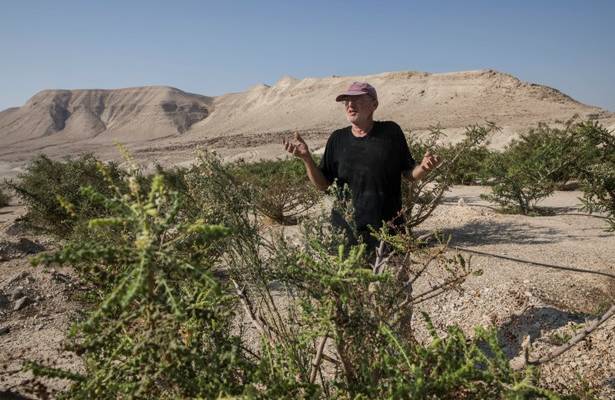An Israeli farmer is rediscovering the properties and uses of the rare tree that was key in producing biblical-era honey.
By: AP and United with Israel Staff
An Israeli farmer has cashed in by making exotic honey from a rare tree that produces frankincense — the resin once worth its weight in gold and venerated in the Bible.
Guy Erlich’s Balm of Gilead Farm is home to 1,000 threatened Boswellia sacra — the perfume-producing desert shrub mentioned in the Bible. He hopes these and his cornucopia of other medicinal plants will yield remedies for human ills.
The farm’s address at Almog is just 6 kilometers (4 miles) from the Dead Sea, where Erlich cultivates and studies threatened desert plants.
“I focus on plants that few other people in the world cultivate. That’s how I have a chance to succeed in the years to come,” he said. “These are also very important plants, and if they’re not cultivated they’ll disappear.”
Boswellia sacra is native to the deserts of northern Somalia, Yemen and Oman, and is threatened by over-harvesting of its precious resin, according to the International Union for Conservation of Nature. Mature Boswellia trees are scored to extract the resin, which hardens into lumps ranging from white to pale green in color. Top grade frankincense can sell for hundreds of dollars per kilogram (pound).
Most frankincense comes from trees tapped in the wild, rather than grown on plantations. The tree is not indigenous to the Levant, but its resin has been valued in the region for millennia as a highly prized aromatic used in medicine and rituals.
An Ingredient of the Temple’s ‘Ktoret’
It was burned as part of religious ceremonies throughout the ancient Mediterranean world, and was one of the ingredients mentioned in the Bible for the Ktoret, the incense sacrifice in the ancient Jewish Temples. The alleys around Jerusalem’s Church of the Holy Sepulcher, where many Christians believe Jesus was crucified, entombed and resurrected, are redolent of the frankincense that vendors burn to entice pilgrims to buy chunks of the yellow resin.
While his Boswellia trees are still too young to produce frankincense, Erlich struck upon honey as a possible source of revenue for his operation.
His first batch of single-source honey made from the desert plants’ tiny flowers sold for $1,000 a kilogram (nearly $500 a pound).
The amber-hued, exceptionally sweet honey has earthy undertones and a slightly astringent finish. In less than a month, Erlich says he exhausted his initial four kilogram (9 pound) stock, selling most of it to customers in the United States.
“I’ve started a waiting list for orders,” he said.
Fighting Off Boycotts
Yet politics always looms in the background. Erlich said a Palestinian-led effort to boycott goods produced in Judea and Samaria has taken a toll on his business, with a major American investor jumping ship a couple of years ago out of concern about the boycott threat.
Despite this anti-Israel sentiment, Erlich said he hopes to foster cooperation with his Palestinian neighbors and turn his farm into a research center for medicinal plants. He also is growing 10,000 Commiphora gileadensis, the fragrant biblical “Balm of Gilead” shrub and namesake of the farm.
“I would be very happy to one day see this as an international project,” he said, the biblical city of Jericho behind him in the distance. “If my plants can also serve as a catalyst to unite Israelis and Palestinians, and perhaps other neighbors around, then I am all for it,” he added.
Rediscovering Ancient Natural Remedies
Erlich and others are starting to look to the Boswellia’s medicinal properties.
Besides aromatic compounds and the hallucinogen incensyl acetate, frankincense has an anti-inflammatory compound called boswellic acid, said Jason Eslamieh, an Arizona botanist and author of several publications about the plant. The resin is a cocktail of complex organic compounds, and “it will take many, many years to really figure out what exactly is in frankincense that will be helpful,” Eslamieh said.
Clinical research has shown that boswellic acid can sometimes reduce inflammation in humans. But much remains unknown. A university in Muscat, Oman, is hosting what is touted as the first international conference about the medicinal benefits of frankincense later this month. Erlich said he doesn’t plan to attend.
Eslamieh said that growing demand for frankincense in traditional Chinese other alternative medicines has helped put “an incredible amount of stress on the natural habitat of the Boswellia.” For now, farms like Erlich’s are rare.
Boswellia trees take around 10 years to become mature enough to be tapped for their resin. Erlich’s oldest plants are still years away from that point.
In the meantime, Erlich sent the Frankincense honey to a Tel Aviv University laboratory to test what active compounds from the plant are present.
While he’s pleased to have found a profitable byproduct from the young trees, he still has a hurdle to overcome ahead of his next honey harvest.
“I’m personally a bit afraid of bees, but it looks like I’ll have to get over it,” he said.
